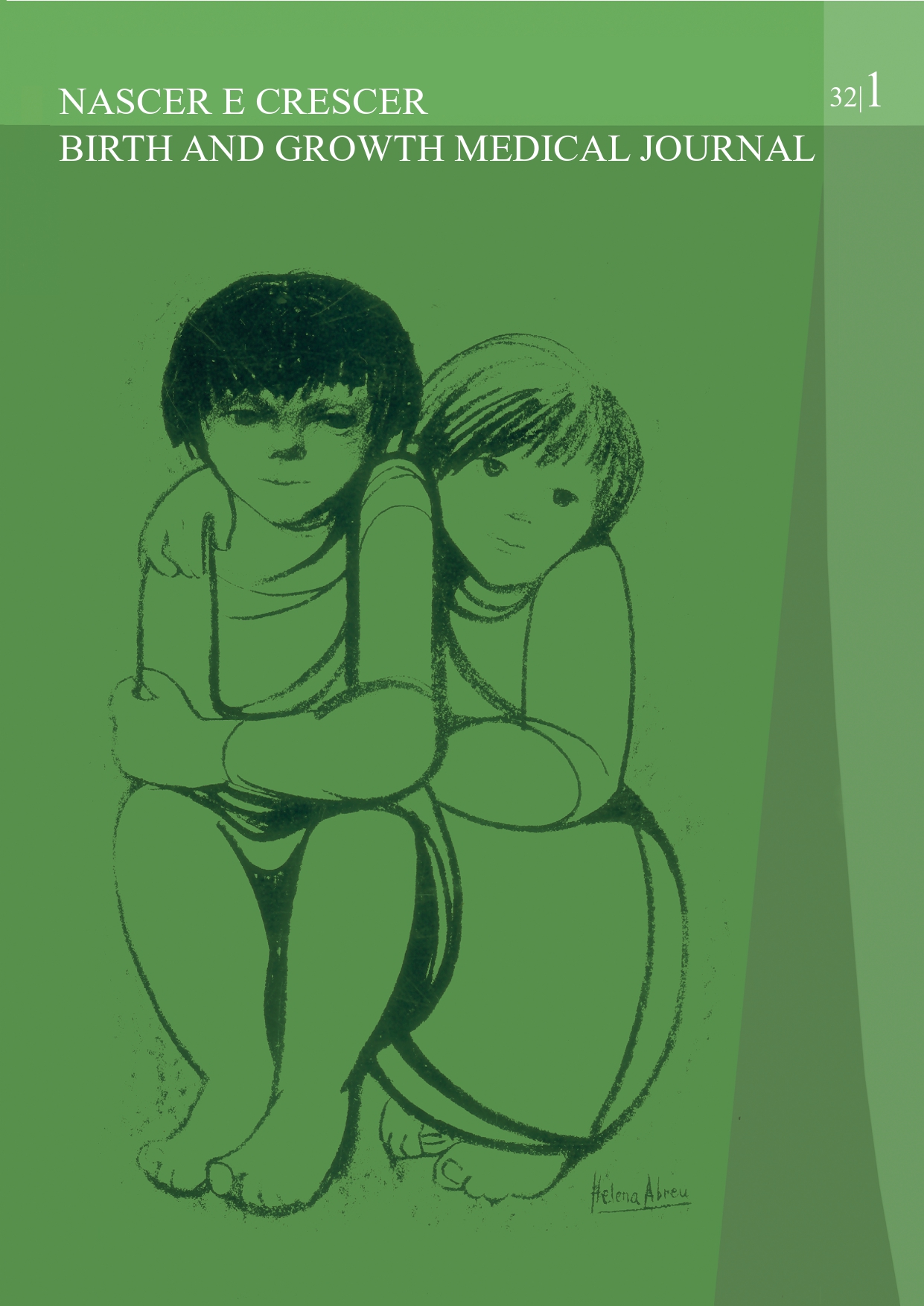Factors related to β-cell residual function in the diagnosis of type 1 diabetes mellitus
DOI:
https://doi.org/10.25753/BirthGrowthMJ.v32.i1.26262Keywords:
β-cell function, c-peptide, type 1 diabetes mellitusAbstract
Objective: To identify factors associated with C-peptide levels at the diagnosis of type 1 diabetes mellitus (T1DM).
Material and Methods: Retrospective review of the clinical records of patients with newly diagnosed T1DM admitted to a Portuguese reference center between August 2010 and July 2019.
Results: The study included 109 subjects, with a mean age at T1DM diagnosis of 8.6 years and 29.4% already showing puberty development. The mean body mass index (BMI) z-score was 0.09. Subjects presented a median fasting C-peptide level of 0.46 ng/mL and a median hemoglobin A1C (HbA1C) of 10.85%. Diabetic ketoacidosis was identified in 22% of patients.
A positive correlation was found between fasting C-peptide levels and age at diagnosis (p<0.001) and between fasting C-peptide levels and BMI z-score (p=0.041). Higher C-peptide levels were found in overweight/obese (p=0.008) and pubertal (p<0.001) individuals. C-peptide levels were found to be correlated with serum bicarbonate (p=0.005) but not with venous pH, HbA1C, or previous symptom duration. No statistically significant differences were observed in fasting C-peptide levels according to gender, diabetes autoantibodies, T1DM family history, or seasonality.
Conclusion: Older, pubertal, and overweight/obese children presented higher C-peptide levels. In the acute setting, serum bicarbonate was the biochemical parameter that best correlated with residual β-cell function.
Downloads
References
Ehlers MR. Immune interventions to preserve beta cell function in type 1 diabetes. Journal of investigative medicine: the official publication of the American Federation for Clinical Research. 2016;64(1):7-13.
Couper JJ, Haller MJ, Greenbaum CJ, Ziegler AG, Wherrett DK, Knip M, et al. ISPAD Clinical Practice Consensus Guidelines 2018: Stages of type 1 diabetes in children and adolescents. Pediatric diabetes. 2018;19 Suppl 27:20-7.
Keenan HA, Sun JK, Levine J, Doria A, Aiello LP, Eisenbarth G, et al. Residual insulin production and pancreatic ss-cell turnover after 50 years of diabetes: Joslin Medalist Study. Diabetes. 2010;59(11):2846-53.
Hwang JW, Kim MS, Lee DY. Factors Associated with C-peptide Levels after Diagnosis in Children with Type 1 Diabetes Mellitus. Chonnam medical journal. 2017;53(3):216-22.
Leighton E, Sainsbury CA, Jones GC. A Practical Review of C-Peptide Testing in Diabetes. Diabetes therapy : research, treatment and education of diabetes and related disorders. 2017;8(3):475-87.
Wolfsdorf JI, Glaser N, Agus M, Fritsch M, Hanas R, Rewers A, et al. ISPAD Clinical Practice Consensus Guidelines 2018: Diabetic ketoacidosis and the hyperglycemic hyperosmolar state. Pediatric diabetes. 2018;19 Suppl 27:155-77.
Szypowska A, Groele L, Wysocka-Mincewicz M, Mazur A, Lisowicz L, Ben-Skowronek I, et al. Factors associated with preservation of C-peptide levels at the diagnosis of type 1 diabetes. Journal of diabetes and its complications. 2018;32(6):570-4.
Yu HW, Lee YJ, Cho WI, Lee YA, Shin CH, Yang SW. Preserved C-peptide levels in overweight or obese compared with underweight children upon diagnosis of type 1 diabetes mellitus. Ann Pediatr Endocrinol Metab. 2015;20(2):92-7.
Leete P, Mallone R, Richardson SJ, Sosenko JM, Redondo MJ, Evans-Molina C. The Effect of Age on the Progression and Severity of Type 1 Diabetes: Potential Effects on Disease Mechanisms. Current diabetes reports. 2018;18(11):115.
VanBuecken DE, Greenbaum CJ. Residual C-peptide in type 1 diabetes: what do we really know? Pediatric diabetes. 2014;15(2):84-90.
Kim S, Park M. Effects of growth hormone on glucose metabolism and insulin resistance in human. Ann Pediatr Endocrinol Metab. 2017:145–52.
Liu J, Bian L, Ji L, Chen Y, Chen H, Gu Y, et al. The heterogeneity of islet autoantibodies and the progression of islet failure in type 1 diabetic patients. Science China Life sciences. 2016;59(9):930-9.
Downloads
Published
How to Cite
Issue
Section
License
Copyright (c) 2023 Vera Gonçalves, Liliana Teixeira, Joana Freitas, Maria João Oliveira, Teresa Borges

This work is licensed under a Creative Commons Attribution-NonCommercial 4.0 International License.
Copyright and Authors' Rights
All articles published in Nascer e Crescer - Birth and Growth Medical Journal are Open Access and comply with the requirements of funding agencies or academic institutions. For use by third parties, Nascer e Crescer - Birth and Growth Medical Journal adheres to the terms of the Creative Commons License "Attribution - Non-Commercial Use (CC-BY-NC)".
It is the author's responsibility to obtain permission to reproduce figures, tables, etc. from other publications.
Authors must submit a Conflict of Interest statement and an Authorship Form with the submission of the article. An e-mail will be sent to the corresponding author confirming receipt of the manuscript.
Authors are permitted to make their articles available in repositories at their home institutions, provided that they always indicate where the articles were published and adhere to the terms of the Creative Commons license.


